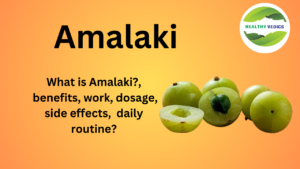Amalaki

Amalaki, also known as Amla or Indian Gooseberry, is a fruit highly valued in Ayurvedic medicine. Here’s a breakdown of your questions:
What are Amalaki?
o Amalaki (Phyllanthus emblica) is a small, round, greenish-yellow fruit that grows on a tree native to India. It’s renowned for its high vitamin C content and antioxidant properties.
How many calories are there in Amalaki?
According to information found:
- A half-cup serving of amla berries contains approximately 36 calories.
- Information found on iherb regarding Amla powder, states that a 4 gram scoop contains 15 calories.
- Therefore the caloric amount will change depending on the form, and amount of amalaki consumed.
What substances are there in Amalaki?
Amalaki is rich in:
- Vitamin C
- Antioxidants (including flavonoids and tannins)
- Fiber
- Various minerals and vitamins
What are the benefits of eating Amalaki?
Potential benefits include:
- Boosting the immune system.
- Improving digestion.
- Promoting healthy skin and hair.
- Supporting eye health.
- Helping to regulate blood sugar levels.
- Cardiovascular support.
What are the disadvantages of Amalaki?
Potential disadvantages and side effects:
- May cause digestive upset in some individuals.
- Can have a blood thinning effect, so caution is advised for those on blood-thinning medications.
- May lower blood sugar, so caution is advised for those with diabetes.
- Can have a drying effect.
When should Amalaki be eaten?
Amalaki can be consumed at various times. Many people consume it on an empty stomach in the morning to maximize absorption of vitamin C.
How should Amalaki be eaten?
Amalaki can be consumed in various forms:
- Raw fruit.
- Juice.
- Powder.
- Pickled.
- Candied.
Which disease is cured by eating Amalaki?
Amalaki is not a “cure” for diseases, but it’s used to support overall health and well-being. It has been used traditionally to support conditions such as:
- Weakened immune system.
- Digestive disorders.
- High blood sugar.
How many Amalaki should be eaten in a day?
- Dosage varies depending on the form of Amalaki and individual needs. It’s best to consult with a healthcare professional or an Ayurvedic practitioner for personalized recommendations.
- Consuming a small amount of the fruit or a tablespoon of amla powder daily is a common practice.
It’s always advisable to consult with a healthcare professional before incorporating Amalaki into your diet, especially if you have any underlying health conditions or are taking medication
For more information Visit us :
Website: https://www.healthyvedics.com/
Website Blog: https://www.healthyvedics.com/blog/
Subscriber: https://www.youtube.com/@healthsrainbow4897
Facebook Page: https://www.facebook.com/profile.php?id=100072760131036
Facebook Main Page: https://www.facebook.com/profile.php?id=61551851110556
Instagram: https://www.instagram.com/healthyvedics/
Twitter: https://twitter.com/HVedics
RELATED VIDEO :
- benefits of turmeric : https://youtu.be/ghuW333IV_k
- benefits of eating licorice : https://youtu.be/GClU0qSkOSQ
- Benefits of eating cumin : https://youtu.be/7YTOgdx24Mg
RELATED ARTICLE :
- benefits of liquorice : https://www.healthyvedics.com/blog/2021/10/14/
- benefits of Yohimbine : https://www.healthyvedics.com/blog/2021/10/14/
- benefits of Ashwagandha : https://www.healthyvedics.com/blog/2021/10/09/
VISIT OUR WEBSITE :
This video Covers the information about:
What are Amalaki? How many calories are there in Amalaki? What substances are there in Amalaki? What are the benefits of eating Amalaki? What are the disadvantages of Amalaki? When should Amalaki be eaten? How should Amalaki be eaten? Which disease is cured by eating Amalaki? How many Amalaki should be eaten in a day?
PUBLISHED BY HEALTHS RAINBOW